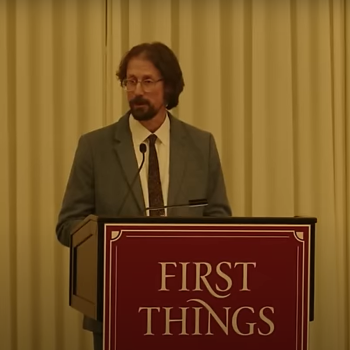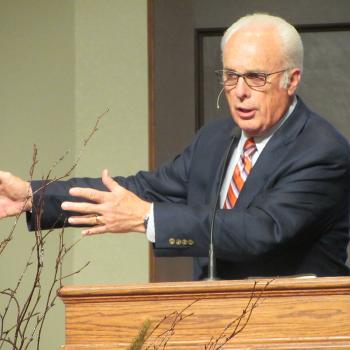
Three years ago, I was a very enthusiastic writer with a very small audience. I’d been WordPressing it for years, dipped my toe into the world of freelancing, made a little side cash, had a Twitter, but few people outside of a couple niche areas were aware of my existence. Which was fine by me. At the time, I was hard at work in the middle of my math doctorate, deep in the daily grind of classes and prelim prep. Writing was fun to fit around the corners, but my days were full.
And then the dragons arrived.
Not really. What actually happened was that Jordan Peterson arrived. And then I started to write about him. And then, thanks to then-editor Bart Gingerich, I joined Patheos in summer 2018.
Ah, bliss it was in that summer to be a faith and culture blogger. The Peterson wave was just cresting. The air was abuzz. And complete strangers still gathered together in large crowds to enjoy things. One of those things was a series of four staged talks between Peterson and Sam Harris, sponsored by Travis Pangburn and moderated by Bret Weinstein and Douglas Murray (in Vancouver and the UK, respectively).
In later months, when Pangburn was exposed as a terminally incompetent, air-headed fraudster, fans of the so-called “Intellectual Dark Web” would look back fondly on these events as a promise of What Could Have Been. Even if the whole thing did have a whiff of “GQ spread for nerds,” still there was something a little exciting about seeing three serious chaps in natty suits walk onto a stage and sit down for multi-hour rambling chats on Life, the Universe and Everything, to be cheered on with the sort of energy generally reserved for arena-rock concerts.
So, in true nerd style, I got my mitts on some bootleg tapes of the events before they came out and whipped up a Take. I was pleased to see a healthy bump in my stats right away, but I expected them to hit a nice modest peak and then gently descend, in the manner of the typical modestly successful blog post. However, as luck and Google had it, this is not what happened. The piece was tweeted out by Peterson himself, circulated around various Reddit subs, and, remarkably, enjoyed good feedback from Peterson and Harris fanboys alike (even though my considered opinion was that in some sense both of them struck out—I came away feeling as if the moderators had a clearer grasp of the two sides than either of them). Suffice it to say, my editor was happy, and things have sort of unfolded nicely from there.
Why, you ask, am I opening with this walk down memory lane? Because among the various nice messages I got in the wake of All That, I opened my inbox one morning to find one from, of all people, Michael Shermer. Michael, I since realized, had been following Peterson himself and presumably stumbled onto my blog that way. Michael thanked me for capturing the debate well. He presumed (correctly) that I’m a Christian who accepts the literal truth of Jesus’ bodily resurrection. He closed by attaching a short article of his on the topic at the Scientific American, curious for my feedback. At the time, I was knee-deep in Real Analysis, so I let a full reply slip, but I did eventually get to it. I’m unsure if Michael ever saw that reply, though we did have one more friendly brief exchange later.
Fast-forward to last week: The dark days of math grad school are finally behind me. My diploma’s in the mail, and I have taken my first steps, blinking, into the broad, sunlit uplands of Getting a Real Job. Meanwhile, the band that was the Intellectual Dark Web has long since broken up, their erstwhile lead singer is slowly coming out of hibernation, and nobody is hosting anything in arenas any more, least of all extended nerdy rambling chats. But Michael Shermer is a loyal fan. On his own podcast, he hosted Peterson for a near Rogan-length Zoom chat ranging over various topics, including religion. Specifically, Michael was very keen to get to the resurrection.
To Michael’s credit, he broached the topic in a much less abrasive, chivvying way than Sam Harris did on stage with Peterson. At the time, I lingered on the moment when Harris fairly bullied Peterson into answering “probably not” to the question “Did Jesus rise from the dead?” Leaning a bit forward in his chair, a small smile on his face, Sam was clearly enjoying himself far more than Jordan. It was fascinating to watch, not just for the substance of the matter but for the status game underlying it. Suffice it to say, he had a particular purpose with that question, a particular goal.
Shermer is more comfortable with Peterson, because at this point he feels as if he’s got Peterson reasonably well pegged: Peterson is, at heart, a modern man like himself. He’s not a stealth religious apologist, he’s not making excuses for fundamentalists, he understands that we’ve learned things we can’t unlearn now about how Science and Stuff works. He just likes to take the biblical stories and put a mythological spin on them a la Joseph Campbell. In fact, it’s gotten Shermer to thinking differently about the Bible himself. What if he’s been misjudging it all along by trying to take it “literally”? What if it was only ever meant to be a metaphor? What if, as Michael Ruse is fond of saying, the miracle of loaves and fishes wasn’t really a miracle of lunch ex nihilo, but a heart-warming parable about the miraculous power of sharing our lunches with others?
In their conversation, Shermer introduces his take on the resurrection in much the same way he presented it in the old article he sent me three years ago. It will sound familiar to anyone with an interest in the Christian-atheist debate, ultimately reducing to little more than an enthusiastic cover version of David Hume’s greatest hit. In Shermer’s case, it’s routed through philosopher Larry Shapiro, whose pop epistemology book The Miracle Myth he finds especially persuasive.
Tired and tattered as it is, the Humean two-step is worth restating: 1) To overcome the prior improbability of a miracle, the evidence must be not merely good, but “supergood.” This, Shapiro assures the reader, already shoots the resurrection out of the sky, along with every other miracle claim. But, 2) In fact, the resurrection evidence doesn’t even qualify as “good,” let alone “supergood.” (Here, in a rare moment of modesty, Shapiro demurs that he’s no historian, so he defers to the experts, like Richard Carrier.)
Lest you think I’m making up the term “supergood” to mock Shapiro, I can assure you, having carefully read his book, that I am not. Having once introduced it, he repeats it often, informing us, in fact, that it “follows from a mathematical theorem.”
Well, now I’m intrigued. Which one?
It turns out to be Bayes’s Theorem, which in fact goes back to a Christian minister, the Reverend Thomas Bayes. As Shapiro summarizes it, “The theorem describes how one should update one’s beliefs in light of new evidence, so it is perfectly suited to questions about the role of testimony in the justification of belief. In effect, the theorem says exactly what I have been urging in this chapter: if testimony is to justify your belief in an extremely improbable event, you need very good evidence that there’s no better explanation for the testimony.” In Carl Sagan’s words, which Shermer echoes, “extraordinary claims require extraordinary evidence.”
This chestnut really deserves its own name. I’m fond of philosopher Tim McGrew’s affectionate coinage: the argumentum Sagani. It goes something like this:
- Extraordinary claims require extraordinary evidence.
- The claim that a miracle occurred is extraordinary.
Therefore,
- Any evidence supporting it ought to be extraordinary.
- I’m not sure what I mean by extraordinary.
- But whatever you come up with isn’t going to work.
Therefore,
- No one is ever justified in believing a miracle claim.
But let’s return to the Reverend Bayes for a moment. I actually agree with Shapiro: Bayes’s Theorem is, indeed, excellently suited to precisely these questions. There is, in fact, an entire paper by McGrew & McGrew detailing its application to the resurrection testimony, arguing forcefully that the crucial “Bayes factor” — a fraction with the probability of all our available evidence given Jesus’ resurrection on top and the probability of said evidence given no resurrection on the bottom — is top-heavy. That is, it is far more probable that we would have the evidence we do had Jesus risen from the dead than if he had not. Thus, the scales are tipped against even the small prior probability of a miracle claim. Which, sorry Hume, is in fact a possibility in the course of the accumulation of “ordinary” eyewitness testimony.
“But…but…!” Yes, I know. Hume was wrong. He just was. I’m sorry you had to find out this way, but now you know. It’s for the best.
I’ll spare the reader a tedious point-by-point fisking of Shapiro’s book. My point for now in bringing all this up is that I share his enthusiasm for this particular mathematical theorem. I’m just puzzled that he seems to believe his case is helped by its introduction.
I don’t know if Shermer is just unaware of the literature here, so I won’t presume. But I bring it up because Peterson clearly is. When Shermer uses words like “Bayesian” and “probabilistic,” Peterson assumes this is the default “rationalistic approach.” In other words, if Peterson were to put on his modernist hat, to try and think about the resurrection like a rational modern man, he assumes the epistemological cliff would stand just as unassailably high as Shermer says it does. So, he confesses humbly, “There’s a tension there. And I don’t know how to resolve it.”
It pains me deeply to hear this, because if there’s one thing I would shout from the rooftops if I could, to Peterson and to anyone else who would hear, it’s that the tension he feels has been entirely manufactured by centuries’ worth of bad philosophy, bad history, and bad scholarly habits. We can blame Hume for a lot of it. In the 19th century, we could blame writers like Strauss, who himself admitted in so many words that he was ultimately piggy-backing off of Hume. In the 21st century, we have writers like Bart Ehrman, who is also, you guessed it, ultimately piggy-backing off of Hume. Blame who you like, there’s plenty to go around. The point: This tension between the mind and the heart, between the rational and the emotional, simply does not need to exist. It never did. On the reliability of the gospels alone, I hardly even know where to begin. At the risk of tooting my own horn, I’ll link my recent article in The Spectator taking just the gospel of John for starters. This is the proverbial snowflake on the iceberg. To toot someone else’s horn, I could gesture at the work of Peter Williams. Etc., etc., and so on.
But I don’t just want to linger on this, because I don’t just want to linger on what Peterson can’t do, at the moment. In the event that he’s reading this, I want also to commend what he can do, eloquently and movingly, and that is to explain why we human beings are still so inexorably drawn to the Christian story. Literature, he reasons, speaks to what is most true, and the greater the literature, the greater the truth. And what greater literature is there than the Bible? And if the Bible is so profoundly true on “the narrative level,” as Peterson phrases it, then can anyone say with complete confidence that it couldn’t also be true on “the material level?” Can anyone say with complete confidence that the two cannot “touch?”
Peterson uses “narrative” and “material” interchangeably with “subjective” and “objective,” respectively, which seems misguided—why should “objective” be synonymous with “material?” Are mathematical and moral truths not also “objective,” even though we can’t measure them with a Geiger counter? This confusion requires a post unto itself. Nevertheless, we can still see why Sam Harris was fidgeting in his plush leather armchair on that stage three summers ago: Because Peterson won’t close the door. He wants to leave a crack for light to come in. He wants to allow that light could come in, that Logos could be made flesh and dwell among us.
Why does he want to allow this? Because, on some profound level he himself struggles to articulate, so much else would make sense if it were true. So many other puzzle pieces would snap in place around this, the missing piece. To quote Dennis O’Driscoll’s “Missing God”:
Miss Him when the radio catches a snatch
of plainchant from some echoey priory;
when the gospel choir raises its
collective voice
to ask “Shall We Gather at the River?
or the forces of the oratorio converge
on I Know That My Redeemer Liveth
and our contracted hearts lose a beat.
Here I am reminded of a powerful passage from Andrew Klavan’s memoir The Great Good Thing, where he describes the moment, driving down the highway, when that light finally broke in on him, and he realized he was on the threshold of Christian faith. Indeed, the more he reflected on it, nothing seemed more natural. The passage is worth quoting at length:
G. K. Chesterton said that in stumbling onto his Christian faith he was like an English yachtsman who had gone off course: he thought that he had discovered a new island when, in fact, he had landed back in England. I saw now that I was like an archaeologist who, after a lifetime of digging, had unearthed the lost foundations of a civilization that turned out, in fact, to be his own. I had spent fifty years of reading and contemplation and seeking and prayer and I had managed to do nothing more than reinvent the Christian wheel.
What were my five epiphanies if not tenets of Christian faith? The truth of suffering was the knowledge of the cross. The wisdom of joy was the soul’s realization through relationship with God. The reality of love was the personality of the Creator as only Jesus had ever revealed it. The possibility of clear perception was the sign that we were made in God’s image, that we had the ability to know his good as our good, even if only through a glass darkly.
Then there was the laughter at the heart of mourning, my bizarre but ever-present sense that, despite our grief and fear and suffering, some essential comedy lived at the center of tragic existence. What could that be if not the realization that this life is not what we were meant for, that death is not what we were meant for, that who we are is not who we’re supposed to be? Even the lowest form of humor—maybe especially the lowest, the most basic form—suggests that we were intended to be something higher than ourselves. A man who slips on a banana peel and falls into a puddle of mud is funny not because of his pain but because of the contrast with his sense of dignity. He feels he is something high, but he has become something low and ridiculous. So it is with us when we sin. So it is with us even when we die. We are meant for something better, and we know it, and even as we suffer and mourn, we also laugh.
In response to the call to baptism, I examined my theology and I saw that—in theory at least, philosophically at least—I was, in fact, a Christian, yes. I believed in the Father, the loving Creator: I had seen his power with my own eyes. I believed in the Holy Spirit, the communication between God and man: I had experienced it for myself through prayer and it had brought my life to fullness. And because I believed that man was made in God’s image, I also believed it was possible that, at the right moment in history, a man could be born who was God incarnate. I believed in Christ . . . in theory; philosophically. The possibility of the incarnation followed logically from everything else.
Yet even here, belief “in theory” still wasn’t enough. “It was not enough for me to feel—as I did feel—that the Jesus story said fully and precisely and uniquely what I believed to be the truth about God and our relationship with God. For me to accept baptism, the Jesus story had to be true on every level, not just as myth but as myth and history combined. That was the whole point.” Here Andrew’s inner Hume began to protest: “Look around you. There are no miracles. There can be no resurrection. The clockwork world is all in all.”
But this, he knew now, “was the ultimate irrational prejudice of the human mind: the belief that the symbols of reality are more real than the reality they symbolize.”
In the end, it was in re-examining the shortest of gospels that his last resistance crumbled: the abrupt, jagged torn edge at the end of Mark, presenting him with the simple picture of the empty tomb. Like John, he looked in, and had faith.
A months-long cross-examination process followed: “Was my Christian faith nothing more than some Freudian longing for divine parental love? Was it some sort of angry strike against my father? Was it a Jew’s desire for assimilation into the greater culture? Was it the resurgence of an old neurosis? On and on. Yet, in the end, I found my faith remained.” Here he echoes C. S. Lewis: “The story of Christ’s life, death, and resurrection not only made sense in itself, it made sense of everything I had experienced and everything I had come to know. It made sense of the world.”
I’ve quoted from Andrew at such length here because his is not a paint-by-numbers story. He didn’t read a book on five minimal facts for the resurrection and see the light. His revelation was a slow burn, a gradual awakening. It was the apprehension of that which Robert Downey Jr.’s character dimly perceives in a scene from The Soloist, where he drunkenly explains to his ex-wife how moved he was when he attended a symphony with a homeless schizophrenic: “I’m watching him, he’s watching the music, and while they’re playing I say my God, there is something higher out there, there is something higher… I mean, I don’t even know what you f—ng call it.”
His ex-wife smiles a little: “Grace.”
“HUH?” RDJ yells over the bar hubbub.
“GRAAAAACE!” she repeats.
“Ooooh! Grace! Okay, thank you! Yeah.”
Might I, as a certified nerd, prefer that the convert’s path be slightly straighter, that each step on the way be marked with greater clarity and more substantiating detail? I might. When I perceive a divided mind, I feel an urge to mend it. But we are complex creatures. We don’t respond to one sort of stimulus only. We were not created to process one kind of evidence only. Some journeys start at the top and work their way down. Some work their way from the bottom up. Peterson, like Klavan, is feeling his way up from the bottom. God willing, one day, he will step into the light.
Meanwhile, I will let Updike address Michael Shermer’s attempt to save Jesus for the modernists, and leave it at that:
Let us not mock God with metaphor,
analogy, sidestepping transcendence;
making of the event a parable, a sign painted in the
faded credulity of earlier ages:
let us walk through the door.The stone is rolled back, not papier-maché,
not a stone in a story,
but the vast rock of materiality that in the slow
grinding of time will eclipse for each of us
the wide light of day.












